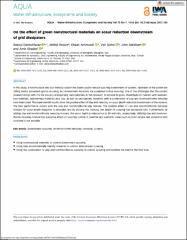On the effect of green nonstructural materials on scour reduction downstream of grid dissipators
Citation
Daneshfaraz, R., Rezaie, M., Aminvash, E., Süme, V., Abraham, J. & Ghaderi, A. (2023). On the effect of green nonstructural materials on scour reduction downstream of grid dissipators. AQUA - Water Infrastructure, Ecosystems and Society, 72(7), 1344-1357. https://doi.org/10.2166/aqua.2023.108Abstract
In this study, a nonstructural and eco-friendly solution has been used to reduce scouring downstream of screens. Upstream of the screen are stilling basins protected against scouring, but downstream locations are subjected to flow scouring. One of the challenges that the current research brings with it is the process of dispersing nanomaterials. In this research, to achieve its goals, three beds of channels with sedimentary materials, sedimentary materials plus clay, as well as sedimentary materials with a combination of clay and montmorillonite nanoclay have been used. The experimental results show the positive effect of clay and nanoclay on scour depth reduction downstream of the screens. The best performance occurs with the clay and montmorillonite clay mixture. The positive effect of clay and montmorillonite nanoclay mixture for scour length reduction is observed, and by utilizing this mixture, the length of scouring has decreased 33%. Furthermore, by adding clay and montmorillonite nanoclay mixture, the scour depth is reduced up to 39 and 46%, respectively. Utilizing clay and montmorillonite nanoclay mixture has a positive effect on scouring control. It could be very useful for cases such as rivers where bed protection with concrete is not possible.


















